Aldwych: a not so abandoned station just below us
Posted in 1900-1909, 20th Century, Architecture, Places, Transport, wartime and tagged with 20th centhury london, Aldwych, Lost Strand, transport, transport history, underground
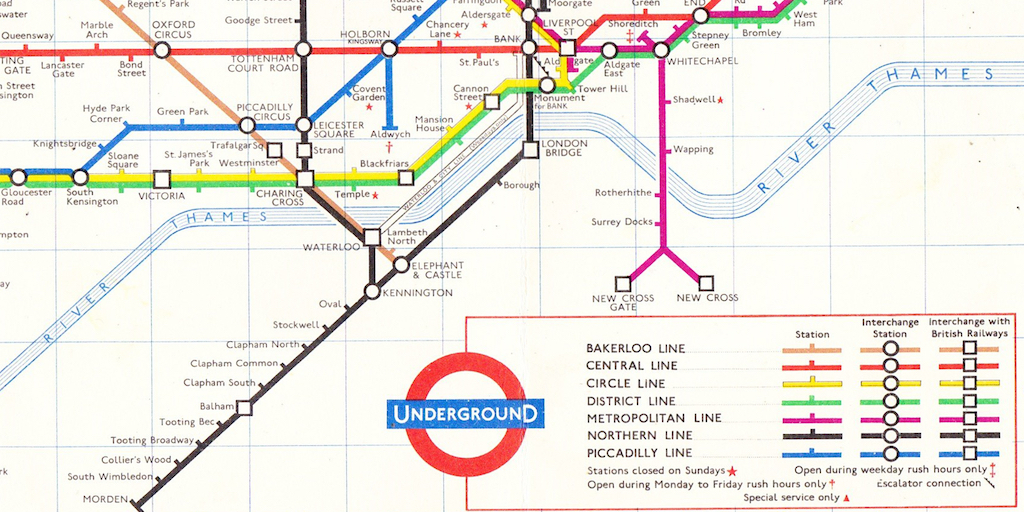
The Aldwych underground station on the junction between the Strand and Surrey Street has been closed for nearly thirty years. This lonely station, that stands at the place of the former Royal Strand Theatre, was part of a one-station branch of the Piccadilly line that connected to Holborn station.
This short back-and-forth shuttle service to Holborn, a journey that only takes 6 minutes by foot, feels like a planning error made by transport authorities. However, the station’s turbulent history reminds us how many stories lay beneath the surface of the Strand.
The station’s strange isolated location relates to the fact that it was constructed by the Underground Electric Railways Company of London to be the terminus of Great Northern and Strand Railway, following an 1899 plan to decongest other main lines. This project evolved, and when the station opened on 30th November 1907 it was integrated as part of the Piccadilly line. This line is made of the fusion of three distinct line projects, all constructed with different planning permissions (the Great Northern & Strand Railway, the Brompton & Piccadilly Circus Railway and the Deep Level District). We must remember that when the Underground was being developed, lines operated rather more independently of each other.
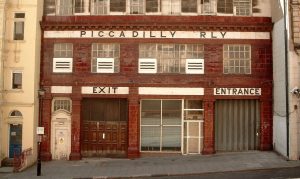
Aldwych station, Surrey street entrance and exit (2007)
The front of the station, designed by Leslie Green (1875-1908) follows an Edwardian Baroque house style. The façade of its two separate entrances are tiled with oxblood faience made by Leeds Fireclay Co Ltd. Below the surface, the station also features wooden ticket office windows, mauve granolithic flooring and timber clad lifts.
In 1915, the Strand station was renamed Aldwych station, in order to avoid confusion with Charing Cross Station that used to be called Strand too. Pessimist traffic previsions and physical constraints led the station’s platforms to be built only 250 feet long, that is to say, a hundred feet shorter than most mainline platforms.
From its beginning, the station suffered from its surprising location. In March 1908, service was reduced to a single train and a few months later the late-night theatre service was stopped. In 1917, lack of traffic put an end to Sunday service and the station’s second platform was closed.
The station did, however, become especially popular throughout the 1919 heatwave as newspapers like the Leeds Mercury described it to be “London’s coolest spot”: “a refreshing oasis”. The station was also the scene of violent actions such as the 9th August 1927 homemade bomb explosion in the men’s cloakroom, which caused damage and panic but no injuries. The Northampton Chronicle and Echo debated the nature of this event, wondering “Is it the work of communists or a practical joke?”. Most finally agreed on the latter.
The station later played an important role during the war. On 22nd September 1940, the train service to Holborn was closed and the station officially became an air-raid shelter. The 15th October 1940 Derby Daily Telegraph, in an article entitled “Tube pedestrian” describes how a woman took refuge in the station and walked along the tracks to Holborn to escape. Soon, the 320 yards of tunnel between Aldwych and Holborn were equipped with first aid facilities, offices and a canteen.
On 9th October 1940, the shelter was even animated by a concert by the Entertainments National Service Association (ENSA). During the same month, the station was made a symbol of national resistance as it was the set for a staged shoot showing young children calmly sleeping between the tracks. In May 1945, up to 2500 used the station’s tunnel as shelter.
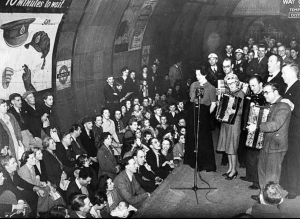
Underground concert (9 October 1940) Bishop Marshall. © Daily Herald Archive/National Science & Media Museum / Science & Society Picture Library
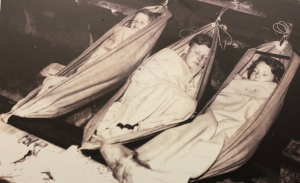
Staged shoot of children sleeping between the tracks (October 1940) London Transport collection
The British Museum and the National Gallery also used the station’s empty tunnels to shelter art from the bombings thanks to the 1938 licence for ‘emergency storage of articles’ accorded by London Transport to the government. The Elgin Marbles, for instance, were transported to the London Transport depot at Lillie Bridge, Kensington, and then transferred to railway wagons to Aldwych, where it stayed until November 1948. The Sutton Hoo treasures were also stowed away here. The shelter formerly closed in May 1945 and the service reopened in 1946.
After the war, the service proposed at the station continued to slow down. From 1962 on it was decided that the shuttle service would only run during weekday peak hours. Indeed, the daily number of passengers was around 450. Pre-war proposals to extend the line southwards to join at Waterloo in order to better integrated the station to the overall network, were at this time deemed unrealistic and abandoned.
It was finally the financial situation of the station that motivated its closure. When the closing was announced on 4th January 1993, the station was running at a 150 000 pounds annual loss. The 3 million pounds cost of replacing the original lift to suit new health and safety standards was considered too high compared to the income generated by the station. The Aberdeen Press and Journal lamented “the end of the line” for Aldwych station. Word of month ironically reports that the train’s final running on the 30th September 1994 hosted a bigger crowd than the station had ever seen in the past 87 years.
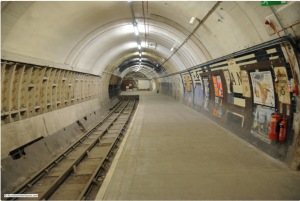
Platform 1, looking in direction of Holborn (2015) A London Inheritance
After its closure, Aldwych station has been far from abandoned, it has instead gained several new uses. Some of them are practical: such as using the platform walls to test new tile and lighting designs, or using the station’s tunnels as a training space for the police, the fire brigade and the underground emergency response unit.
In 2011, the station was awarded a Grade II listing and is periodically available to visit via London Transport Museum. The allure of the abandoned underground station isn’t something new: in 1989, tours and rides on both “vintage tubes” and prototype ‘“tubes of the future” were already organised for visitors according to the Harrow Leader.
Finally, the station is now one of the most famous in the world – even if people might not realise it, Aldwych that has time and time again graced their screens! Its cultural imprint is huge: both before and after closure it has always been an important filming location, appearing in more than thirty films.
Filmed in Aldwych station before closure |
Filmed in Aldwych station after closure |
1952 – The Gentle Gunman1953 – Turn the Key Softly1957 – The Key Man1958 – Gideon’s Day1960 – Piccadilly Third Stop1967 – Ride of the Valkyrie1969 – Battle of Britain ; The Bed Sitting Room1970 – The Walking Suite1971 – Gumshoes1972 – Death Line1974 – The Black Windmill1977 – Rogue Male1981 – Take it or Leave it1987 – Superman IV; Prick Up Your Ears1990 – The Krays1992 – Patriot Games |
1996 – Neverwhere1999 – Tube Tales2000 – Honest2004 – Creep2005 – V for Vendetta2006 – The Good Shepherd2007 – Atonement; 28 Weeks later2008 – The Bank Job; The Edge of Love2013 – Fast & Furious 6; Mr Selfridge2014 – Sherlock2016 – Their Finest2017 – Darkest Hour2018 – The ABC murders2019 – Stan & Olie |
Further reading and references
Aldwych Underground Station (2015) A London inheritance [Online] Available at: https://alondoninheritance.com/tag/aldwych-underground-station/

[…] It’s high up on a wall by the entrance to King’s College London, on the side of the disused Strand station, where it’s almost impossible to see. It marks the spot where William Lilly, ‘Master […]